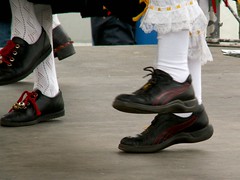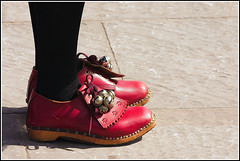
One of the local industries which has died out over the past 50 years or so is that of clogmaking. At one time it was an integral part of the wool trade at the little pandys (fulling mills) here in Wales. The offcuts from the clog-making (alder was used) provided wood to heat the big dyeing vats. Alder grows on stream banks and in very wet woodland (alder carr woodland) so is impervious to water and doesn't crack. Household servants in the past wore clogs or else pattens (imagine a sort of Dr Scholl type sandle with a metal ring screwed to the bottom to keep them out of the mud and wet, and used with or without shoes) for jobs like washing floors or having to go outside in the wet yard.
A neighbour of ours once showed us a large clog which had been shoved into the wall of her barn to make good a gap! The irons on the bottom were rusty, and the leather top was as dry as cardboard, but it was still in one piece, and the wooden part of it still looked good for another 50 years.
There are one or two clog makers who are still in business, making very modern clogs, quite a bit different to the utalitarian ones worn in the past. Modern clogs often have the leather tops dyed in bright colours, and at the Welsh Eistedfodds, we still have clog dancing competitions.

It was a summer job. The clogger and his family would set up camp in the alder groves, having bought a stand of timber there to cut for the clog making, and dependent on the size of the stand they'd bought, might be there for between two and four weeks. The timber would be cut down and sawn to length, and then split and roughly shaped into blocks with special clogging knives. This was green wood, unseasoned, and this meant it was easier to shape. The rough blanks would be stacked in tall pyramids and taken to the factory. Lancashire was one of the clog-making centres. This whole process continued throughout the summer.
When the clog bases were sold on, the village clog maker would put the leather tops on them. He would have paper patterns of the feet of all the villagers and he was the one who kept them dry-shod. John Seymour, in his book 'The Forgotten Arts' mentions a clog maker who was still working at the time that John Seymour wrote his book, but as this was 1984, I assume that Luther Edwards of Cynwyl Elfed (just north of Carmarthen, so not far from us) has gone to join his maker. He apparently served a four and a half year apprenticeship as a boot and shoe-maker, before serving a further 18 months with a clog maker, before he set up on his own. When he was working, he cut all his own wood too, although he preferred sycamore.
The leather tops for the clogs were made from one, two or three pieces of leather, dependent on the design, clogs for women and children having a one-piece design fastened at the front with a button. The leather was helped into a permanent shape by the application of a hot burnishing iron, which tautened it over the metal last inside it. The upper was finished with a welt (strip of leather) right around the rebate, and secured with brass and steel tacks.
Clogs were of course, synonymous with Holland, where they were made totally from wood (but willow in this case) and called klompen, and in France, sabots. This French word is actually the root of the English word 'sabotage', as the French workers in the late 19th century used their sabots to damage machinery during industrial protests. My mum used to tell me to "stop clomping about" so it looks like both words got into the English language.


1 comment:
this is so great. I didn't know you were familiar with John Seymour. I guess you saw the post i did on the book you mentioned. A wonderful book.
Clogging became popular here, as well. As immigrants from Scotland, Ireland and Wales settled the mountains and ridges of the Appalachians through Kentucky and Tennessee, (into the Carolinas, Georgia and West Virginia as well) the dance remained a tradition. I grew up with a clogging tradition and learned to do a bit of it. My brother went so far as to go for lessons and became a very good clogger. My people are all from Kentucky. (and Ireland before that) There was a kind of subculture there in the Appalachian mountains and foothills, of extremely rural people who remained pretty isolated from the rest of the nation and from progress. They lived on the ridges and in the "hollers" and sometimes never went 10 miles from home their whole lives. Much of the beautiful old music with the very Celtic influence comes from there. Some of the old songs which you would recognize became American folk music as well. I'm trying to think of some. Barbary Allen, Lord Thomas, Fair Ellender, and Pretty Polly are a few.
I thought that might interest you.Nancy
Post a Comment